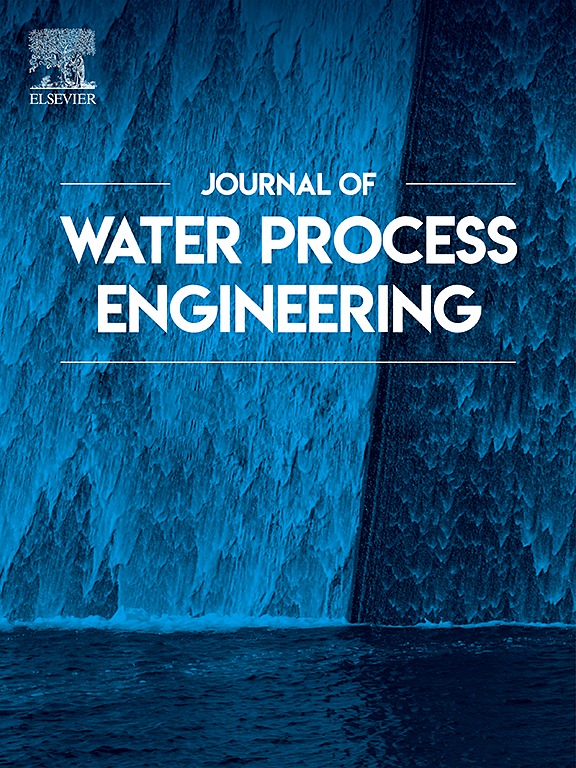Online monitoring of nitrate based on cathodic electroactive biofilm
IF 6.3
2区 工程技术
Q1 ENGINEERING, CHEMICAL
引用次数: 0
Abstract
Online nitrate monitoring is a critical step for the stable operation of sewage treatment plants. Microbial electrochemical sensor based on electroactive biofilms (EAB) is a new type of online water quality monitoring technology. Modifications in the concentrations of organic matter and the existence of readily oxidizable substances in the bioanode sensor can directly impact nitrate monitoring, leading to a reduction in sensitivity. This study developed a rapid online monitoring technique for nitrate by rapidly forming a cathodic EAB through electrode polarity reversal. This resulted in a maximum current density of −3 A m−2 for the biocathode. Nitrate functions as an electron acceptor, with biocathode-attached microorganisms either directly or indirectly acquiring electrons from the biocathode surface to reduce nitrate for metabolic sustenance. Notably, within the concentration range of 0.5 to 15 mg L−1, cathodic EAB exhibited a significant current response to nitrate within 20 min, showing a strong linear correlation with a coefficient of determination (R2) of 0.9754. The immunity to interference was systematically verified through one-factor effects tests and mixed interference experiments. The linear correlation between peak current density and nitrate concentration remained stable (R2 > 0.97) even in the presence of both chemical oxygen demand (COD) and ammonium nitrogen (NH4+-N). The capacity of the microbial sensor monitoring system to swiftly, precisely and reliably discern nitrate concentrations exemplifies the system's efficacy in nitrate monitoring.
基于阴极电活性生物膜的硝酸盐在线监测
硝酸盐在线监测是污水处理厂稳定运行的关键环节。基于电活性生物膜(EAB)的微生物电化学传感器是一种新型的在线水质监测技术。生物阳极传感器中有机物浓度的变化和易氧化物质的存在会直接影响硝酸盐监测,导致灵敏度降低。本研究开发了一种通过电极极性反转快速形成阴极EAB的硝酸盐快速在线监测技术。这导致生物阴极的最大电流密度为−3 a m−2。硝酸盐是一种电子受体,附着在生物阴极上的微生物直接或间接地从生物阴极表面获取电子,以减少硝酸盐的代谢维持。值得注意的是,在0.5 ~ 15 mg L−1的浓度范围内,阴极EAB在20 min内对硝酸盐表现出显著的电流响应,其决定系数(R2)为0.9754。通过单因素效应试验和混合干扰试验,系统地验证了系统的抗干扰性。峰值电流密度与硝酸盐浓度呈稳定的线性相关关系(R2 >;0.97),即使同时存在化学需氧量(COD)和铵态氮(NH4+-N)。微生物传感器监测系统快速、准确、可靠地识别硝酸盐浓度的能力证明了该系统在硝酸盐监测中的有效性。
本文章由计算机程序翻译,如有差异,请以英文原文为准。
求助全文
约1分钟内获得全文
求助全文
来源期刊

Journal of water process engineering
Biochemistry, Genetics and Molecular Biology-Biotechnology
CiteScore
10.70
自引率
8.60%
发文量
846
审稿时长
24 days
期刊介绍:
The Journal of Water Process Engineering aims to publish refereed, high-quality research papers with significant novelty and impact in all areas of the engineering of water and wastewater processing . Papers on advanced and novel treatment processes and technologies are particularly welcome. The Journal considers papers in areas such as nanotechnology and biotechnology applications in water, novel oxidation and separation processes, membrane processes (except those for desalination) , catalytic processes for the removal of water contaminants, sustainable processes, water reuse and recycling, water use and wastewater minimization, integrated/hybrid technology, process modeling of water treatment and novel treatment processes. Submissions on the subject of adsorbents, including standard measurements of adsorption kinetics and equilibrium will only be considered if there is a genuine case for novelty and contribution, for example highly novel, sustainable adsorbents and their use: papers on activated carbon-type materials derived from natural matter, or surfactant-modified clays and related minerals, would not fulfil this criterion. The Journal particularly welcomes contributions involving environmentally, economically and socially sustainable technology for water treatment, including those which are energy-efficient, with minimal or no chemical consumption, and capable of water recycling and reuse that minimizes the direct disposal of wastewater to the aquatic environment. Papers that describe novel ideas for solving issues related to water quality and availability are also welcome, as are those that show the transfer of techniques from other disciplines. The Journal will consider papers dealing with processes for various water matrices including drinking water (except desalination), domestic, urban and industrial wastewaters, in addition to their residues. It is expected that the journal will be of particular relevance to chemical and process engineers working in the field. The Journal welcomes Full Text papers, Short Communications, State-of-the-Art Reviews and Letters to Editors and Case Studies
 求助内容:
求助内容: 应助结果提醒方式:
应助结果提醒方式:


